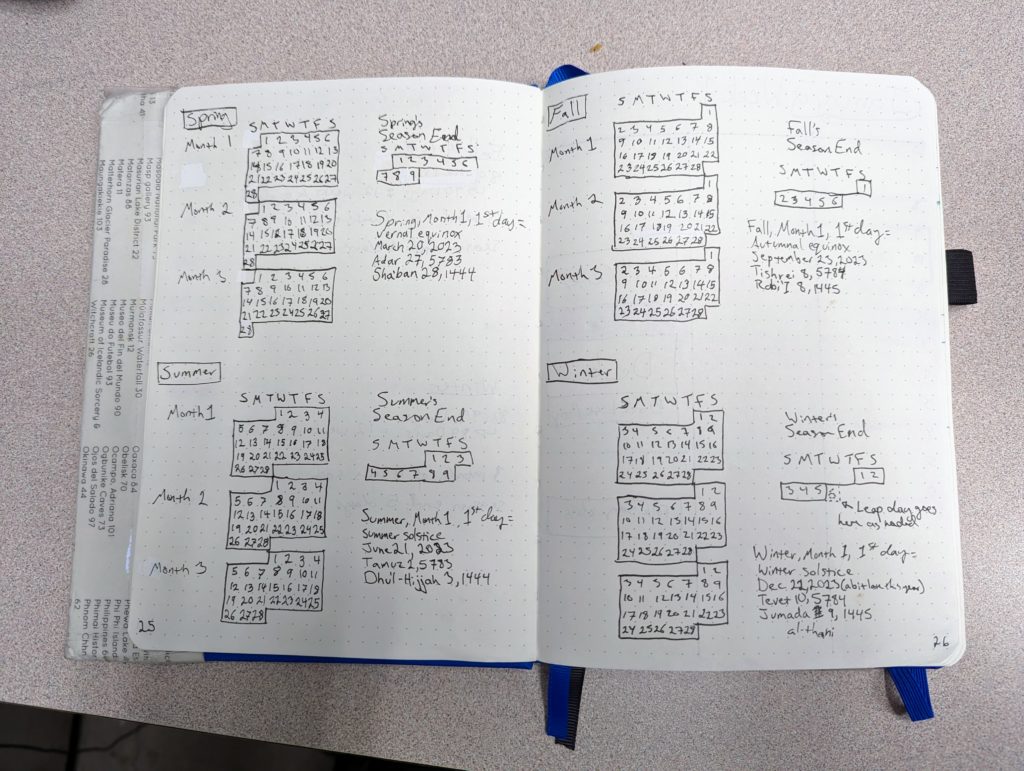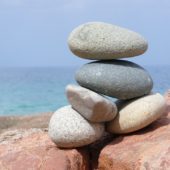For the new year, I’ve decided to replace the calendar. The whole system of tracking what a year is in the first place. Yes, it’s a bit drastic, but think about it: Is this one working for you? Didn’t think so.
I wrote a ton about other calendars, but then I realized that I still hadn’t written the proposal, so, here it is and then I can tell you more things later, if you care to keep reading about them.
Cut to the chase!
My proposed calendar works towards 3 goals. Here they are:
- Set aside time for rest, as a society.
- Explicit connection to the seasons.
- Secular, not connected to any one religion.
And so, here it is! I thought long and hard about changing the length of the week, but in the end I gave that up for reasons of religion. Yes, my goal is an actually secular calendar. But the fact remains that for my proposed calendar to be even slightly accepted, it would need to be religiously compatible with the world’s majority religions, which is to say, it needs a seven day week.
My main innovation is this: The concept of Season-ends. At the end of a week, you get a weekend, right? And yes some people work on the weekends, but it is widely accepted that the majority do not. If you do work weekends, you should be properly compensated for doing so, with extra money and time off at another time. (I know that not all people are, but you still should be.) At the end of a week of work, you get a weekend. I propose that at the end of a season’s worth of work, you should get a season-end.
So, how long is a season-end? Well…that’s a bit more complicated. It depends on the season. You might already be familiar with how seasons work, but here’s a brief refresher: The Earth spins at a bit of an angle, and then also orbits the sun, while spinning. Each spin is a day, each complete orbit is a year. The seasons are caused by that tilt that we are on, tilting away from the sun during the winter, and towards the sun in the summer. Here’s a diagram:


Of course, this is also wildly simplified. But the point is that fall and winter are shorter for the earth to travel in space. So they are also shorter in time. And you can see that on this diagram, so I’ll call this diagram precise enough.
How long are the seasons? Well…
- Spring: 92.76 Days
- Summer: 92.76 Days
- Fall: 89.84 Days
- Winter: 88.99 Days
THIS is what you call cutting to the chase?!
Yes, I know.
Here is the calendar. It starts in spring, because that’s when the flowers bloom and the earth comes alive and honestly I’m at a loss why you would start your calendar at any other time.

As you can see, each season starts on the equinox or solstice, has 3 months and then a season-end. Each month consists of four 7 day weeks, to make a total of 28 days. I didn’t tie it to the lunar cycle, so months do not start on the new moon, but they do echo it in length of time. 3 months of work, and then a season-end. A time to pause, to transition, to rest. And yes, as a society we will still need someone to work at grocery stores and farms etc. My hope is that with this being societally accepted and approved time to chill, the people who work those times can be compensated appropriately, both in pay and in alternate time to rest.
This calendar has 365 days, with a leap day as needed. I took a hint from the calculation of the intercalary month (also known as leap month) of the traditional Chinese calendar (see below), and this leap day is added on an as-needed basis. If the spring equinox is a full day earlier than the first of the year would be, the leap day is added at the end of the year, making a 6th day of winter’s season-end and restoring the calendar to correctness.
So, what do you think? Want to live by my calendar?
While you think about it, here are some other things about other calendars:
Gregorian Calendar
The Gregorian calendar starts in the winter, and goes 365 days, with intercalary (or leap) days on occasion to fix things up. The Gregorian calendar was put in place by Pope Gregory in 1582, as a way to fix the Julian calendar. Specifically, the Julian calendar had started putting Easter in the wrong spot with relation to the in spring equinox, and that would not do. You see, it takes the earth roughly 365.2422 days to travel around the sun, and the Julian calendar assumed that it was 365.25 days, and based on that assumption had the wrong number of leap years. After the mathematicians and scientists had made their recommendations, Pope Gregory declared that October 5-14 would just not happen in the year of 1582. (side note: This should be something that causes time travelers issues in your next novel. Please see to it.)
The Gregorian calendar is sometimes termed the secular calendar, to distinguish it from the religious calendars described below. However, as it being named after a pope should suggest, it’s simply the religious calendar of the dominant religion, and not secular in nature.
Hijri Calendar
The Hijri calendar, also called the Islamic or Muslim calendar, was established by Khalifa Umar I. It consists of 12 lunar months for a 354-55 day cycle. It is strictly lunar in nature, meaning that it follows the moon. Each month is about 28 days long, and starts with the new moon. Intercalation, the practice of adding leap days or months, is expressly forbidden in Islam, and so the months are not fixed in relation to the solar seasons but rather fixed in relation to the moon.
Hebrew Calendar
The Hebrew calendar, also called the Jewish calendar, has a kind of murky history, but is Canaanite and Babylonian in origin. It’s called lunisolar, which means that it has lunar months but does try to line up with the solar seasons. It consists of 12 lunar months with frequent intercalary months. These months used to be added as needed by observation of the seasons (have we harvested the wheat yet? etc), but since the 12th century has been following a cycle that adds a month to 7 out of every 19 years. This makes it mostly follow the solar seasons, though there is some slippage. Every 216 years it loses one day, which is a thing I wrote a whole essay about as a 12 year old. I wonder if I can dig that old thing up?
Chinese Calendar
Also known as the Nongli, Jiuli, or Laoli calendar, the traditional Chinese calendar is also a lunisolar calendar. For this calendar, the months are lunar, just like the Hijri and Hebrew calendars. And just like the Hebrew calendar, it adds intercalary or leap months to stay with the solar seasons. Where it differs is in the calculation of when intercalary months happen, which rather than being on a schedule is calculated against the solstice as observed by astronomers. Because it is tied to this solar event, it cannot slip over time, like the Hebrew calendar can.
Ok but we all agree on 7 day weeks, right?
Nope! I mean, generally speaking, yes the whole world currently runs on a 7 day week. That’s mostly the ancient Babylonians’ fault, with lots of help from Christianity, the Roman Empire, and later the British Empire. But! Historically…
- 4 day week – Igbo (located in current-day Nigeria)
- 5 day week – USSR, Javanese
- 6 day week – Assyria (located in modern-day Iraq, Syria, Turkey, and Iran)
- 8 day week – Ancient Rome, before Christianity and the Julian calendar
- 10 day week- Ancient Egypt, also France for a short while.
Citations? Well…
Here’s the thing. I did this research without knowing I was going to want to write things up and share them with people! So I have to re-find my sources, and that takes time. If I find the time, I’ll come back and add my citations. In the meantime, my apologies.

